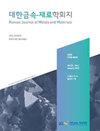Hydrogen Embrittlement Characteristics of Tempered Martensitic Steels under Electrochemical and High-Pressure Hydrogen Environments
IF 1.4
4区 材料科学
Q4 MATERIALS SCIENCE, MULTIDISCIPLINARY
引用次数: 0
Abstract
The effect of hydrogen charging methods on the hydrogen embrittlement characteristics of tempered martensitic steels were discussed in terms of hydrogen diffusion behavior. Two tempered martensitic steels with different Si content were fabricated by quenching and tempering. The steel with high Si content had a lower cementite fraction because the addition of Si changed the morphology of cementite from a long film-like shape to a short-rod shape by suppressing the precipitation and growth of the cementite. To evaluate the hydrogen embrittlement resistance of the two tempered martensitic steels with different Si content, slow strain-rate tensile testing was employed after introducing hydrogen using three types of hydrogen charging methods (ex-situ electrochemical hydrogen charging, in-situ electrochemical hydrogen charging, and in-situ high-pressure gaseous hydrogen environment). For the hydrogen pre-charged tensile specimens using the ex-situ electrochemical charging method, the steel with high Si content had a better hydrogen embrittlement resistance, with a higher relative reduction in area. On the other hand, there was no significant difference in the relative notch tensile strength of the two tempered martensitic steels with different Si content, regardless of the hydrogen charging methods. In addition, the ex-situ hydrogen charging method exhibited higher relative notch tensile strength compared to the in-situ hydrogen charging method due to the release of hydrogen during the tensile test, after exsitu hydrogen charging. This implies that hydrogen embrittlement resistance can be differently estimated depending on the kind of hydrogen charging methods.电化学和高压氢环境下回火马氏体钢的氢脆特性
从氢扩散行为的角度讨论了充氢方式对回火马氏体钢氢脆特性的影响。通过淬火回火制备了两种不同Si含量的回火马氏体钢。高Si含量钢的渗碳体分数较低,这是因为Si的加入抑制了渗碳体的析出和生长,使渗碳体的形态由长膜状变为短棒状。为了评价两种不同Si含量的回火马氏体钢的抗氢脆性能,采用三种充氢方式(原位电化学充氢、原位电化学充氢和原位高压气态氢环境)引入氢后进行慢应变速率拉伸试验。对于非原位电化学充氢法预充氢拉伸试样,Si含量高的钢具有更好的抗氢脆性能,相对面积收缩率更高。另一方面,无论充氢方式如何,两种不同Si含量的回火马氏体钢的相对缺口抗拉强度没有显著差异。此外,由于原位充氢后拉伸试验过程中氢气的释放,原位充氢方法比原位充氢方法表现出更高的相对缺口拉伸强度。这意味着,根据充氢方法的不同,可以不同地估计氢脆抗力。
本文章由计算机程序翻译,如有差异,请以英文原文为准。
求助全文
约1分钟内获得全文
求助全文
来源期刊

Korean Journal of Metals and Materials
MATERIALS SCIENCE, MULTIDISCIPLINARY-METALLURGY & METALLURGICAL ENGINEERING
CiteScore
1.80
自引率
58.30%
发文量
100
审稿时长
4-8 weeks
期刊介绍:
The Korean Journal of Metals and Materials is a representative Korean-language journal of the Korean Institute of Metals and Materials (KIM); it publishes domestic and foreign academic papers related to metals and materials, in abroad range of fields from metals and materials to nano-materials, biomaterials, functional materials, energy materials, and new materials, and its official ISO designation is Korean J. Met. Mater.
 求助内容:
求助内容: 应助结果提醒方式:
应助结果提醒方式:


